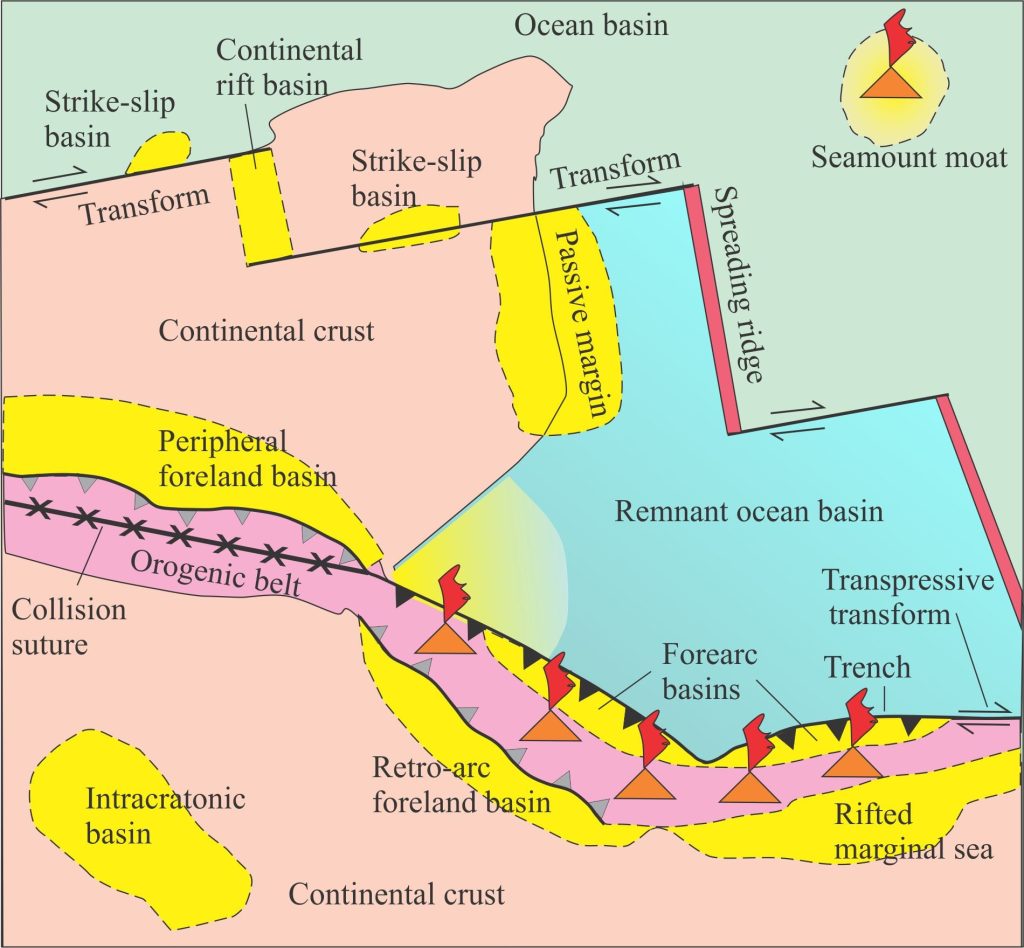

A schematic of sedimentary basins distributed across three continental blocks, an ocean basin (e.g. Pacific basin), and a remnant ocean basin (e.g. Juan de Fuca plate). Key tectonic elements are: subduction zones (black triangles) and associated basins, an orogenic thrust belt resulting from continent-continent or terrane-terrane collision (e.g. Alberta foreland basin) and associated unroofing of a metamorphic core complex (e.g. Omineca Belt, Canadian Rockies), an orogenic belt in the plate above a subduction zone associated with a volcanic arc, continental rifting with a nascent rift basin (e.g. Red Sea), and a much older passive margin sedimentary prism (east coast North America), ocean crust rifting at spreading ridges, basins associated with transform faults, and intracratonic (e.g. modern Hudson Bay) and intra-oceanic basins, the latter depicted as a moat around large sea mounts (e.g. Hawaii). Figure is modified from Ingersoll (1988) who modified it from Dickinson (1980).
The rationale for classification of sedimentary basins
The formulation of plate tectonic theory in the late 1960s led to a complete rethink about how sedimentary basins form; how they subside and how the sedimentary fill is accommodated. The pioneering investigations by W.R. Dickinson and his colleagues laid the foundations for a geodynamic approach to basin analysis, governed principally by plate interactions based on:
- the composition and rheology of the lithosphere (oceanic, continental, transitional)
- proximity to plate boundaries, and
- plate trajectories (extensional, convergent, transform).
Dickinson recognised that sedimentary basins evolve in concert with tectonic plates and plate boundaries. For example, along convergent plate boundaries the relative trajectory may change from purely orthogonal to oblique, with subsequent transitions in the style and mechanisms of subsidence and sediment fill (he also pioneered concepts of sediment routing and provenance in relation to plate tectonic environments).
The plate tectonic environment also provides a rationale for the diversity of basin shapes, sizes, and longevities. For example, compare the rapid subsidence typical of strike-slip (wrench, pull-apart) basins (105 to 106 years), compared with 107 to 108 years for passive margins. The difference in size between these two basin types is also an order of magnitude or two.
[It is worth remembering at this point that all plate motions on Earth, as a sphere, are relative and dictated by poles of rotation, called Euler poles. Thus, orthogonal convergence at some location on a boundary, relative to a pole of rotation, will have corresponding strike-slip or oblique strike-slip motion (transpressional or transtensional), or extensional motion elsewhere. If the pole of rotation moves, then the sense of motion will also change. Motion relative to a pole of rotation can be plotted as a vector that has direction, and magnitude (velocity).]
The geodynamic context of sedimentary basins is embedded in several classification schemes, particularly those proposed by Dickinson (1974), Kingston et al. (1983) , and later iterations by Busby and Ingersoll (1995), Ingersoll (2012), and Allen and Allen (2013). The utility of such schemes lies not just in the convenient labeling of basins but placing them in a broader context of plate history.
Dickinson’s scheme and its later iterations are based on the four main types of plate boundary:
- Divergent, extensional or rifted margins,
- Convergent margins, mostly subduction and/or collision related
- Transform margins bound by lithosphere-scale strike-slip faults, and
- Intraplate settings, that are distant from plate boundaries but are subjected to long wavelength buckling stresses (a few 100 km) generated by plate interactions.
The Kingston et al. classification scheme
The basins classification proposed by Kingston et al. (1983) expanded Dickinson’s plate tectonic modus operandi by incorporating basin-scale depositional style. The rationale for this approach was dictated by the needs of petroleum exploration. Their Figure 1, modified slightly here, is a kind of flow chart that was intended to aid identification of ancient basins.


Sedimentary basin classification according to (and modified from) Kingston et al. (1983), presented as a flow chart. The three primary identification parameters are plotted against the two main crustal domains: continental and oceanic. I have added more recent basin terminology below their main basin types.
Classes of sedimentary basins in their scheme are based on:
- Depositional cycles or stages that represent distinct tectonic episodes. These cycles are basin-scale in thickness and duration, are usually bound by unconformities, and have predictable stratigraphic transitions from marine to non-marine. They also refer to these as depositional sequences and depositional episodes and yet there is no explicit reference to the sequence stratigraphic methodologies of Sloss (1963), Frazier (1974), or the Exxon crew.
- Basin-forming tectonics incorporates two main plate boundary interactions: divergence and convergence, and the proximity of basins to boundaries, i.e. plate margin or plate interior. They regard strike-slip systems as variations of either of these boundary types.
- Basin-modifying tectonics recognises that changes in plate motions will result in significant changes in basin evolution wherein basins may become inverted (uplifted and eroded) or subside according to different mechanisms. This parameter explicitly recognises that many sedimentary basins represent multiple tectonic histories.
The Kingston et al. Scheme identifies 10 theoretical basin types, but for practical purposes excludes two of these (oceanic trench and oceanic fracture types) because they were deemed of little use to petroleum exploration.
The Dickinsonian classification schemes
In a series of papers, Ingersoll (1988, 2012), Busby and Ingersoll (1995) used the Dickinson’s framework to progress successively more complex classification schemes. The latest iteration lists 32 basin types (Ingersoll, 2012). These schemes are based on actual, modern basin analogues where we can be reasonably certain of the association between basins and their plate tectonic setting. Excluded from the classification criteria are the architecture and composition of the basin fill, setting it apart from the Kingston et al. scheme.
Ingersoll’s Table 1.2 (2012) of sedimentary basins has been modified slightly and split into three panels
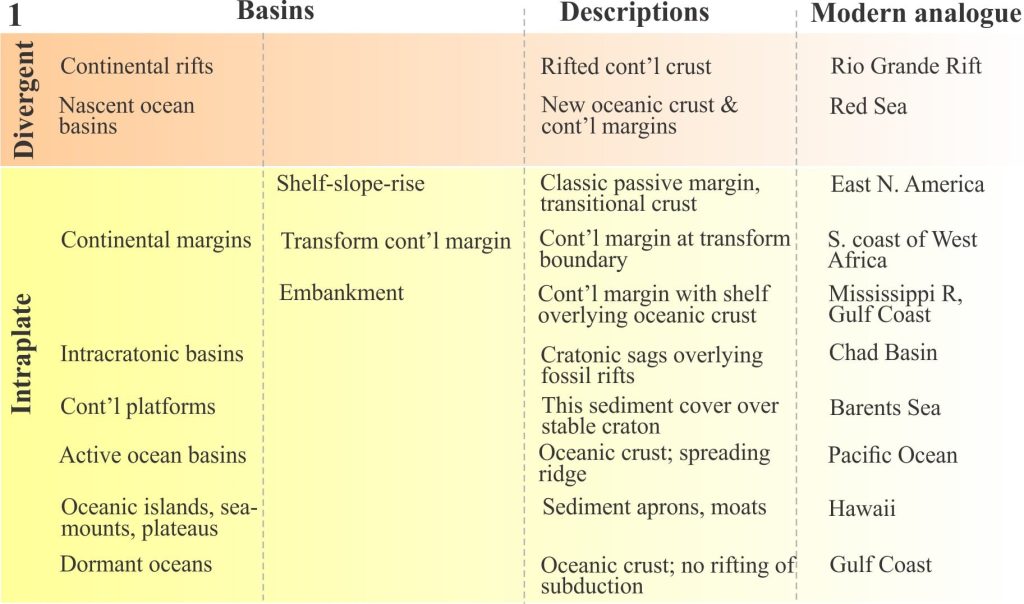

Panel 1. Ingersoll’s Table 1.2 (2012) of sedimentary basins has been modified slightly and split into three panels
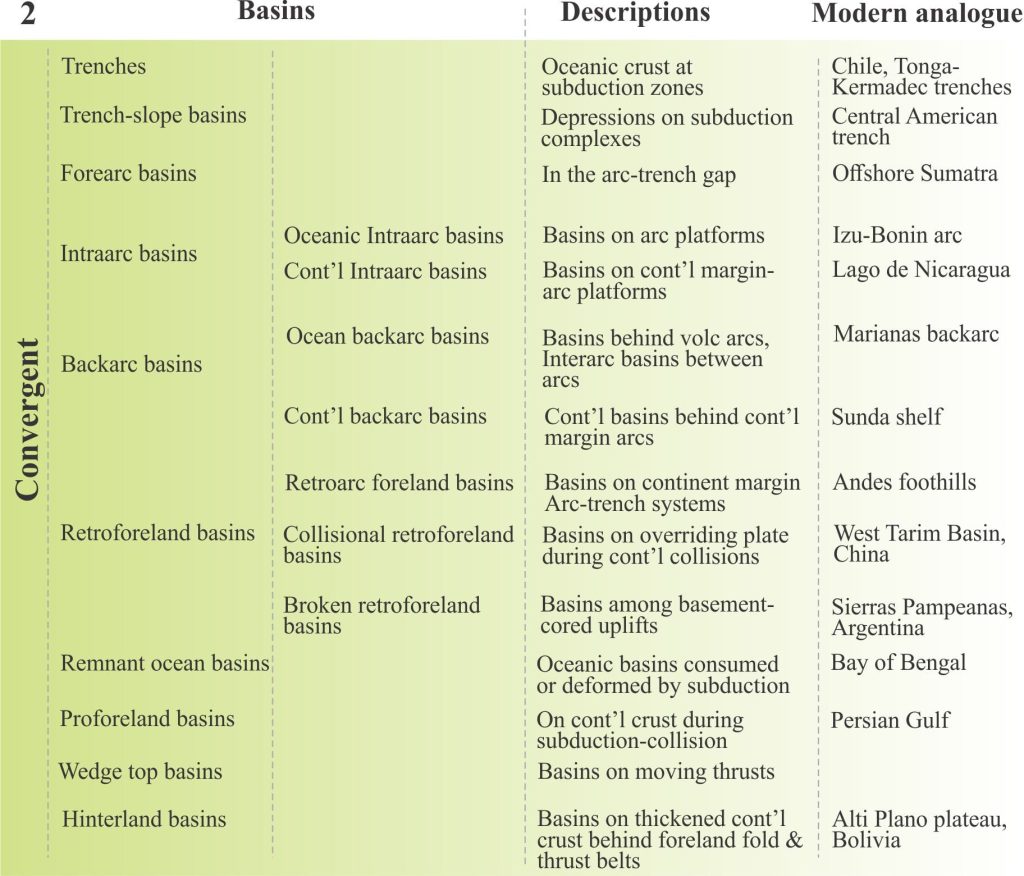

Panel 2. Ingersoll’s Table 1.2 (2012) of sedimentary basins has been modified slightly and split into three panels
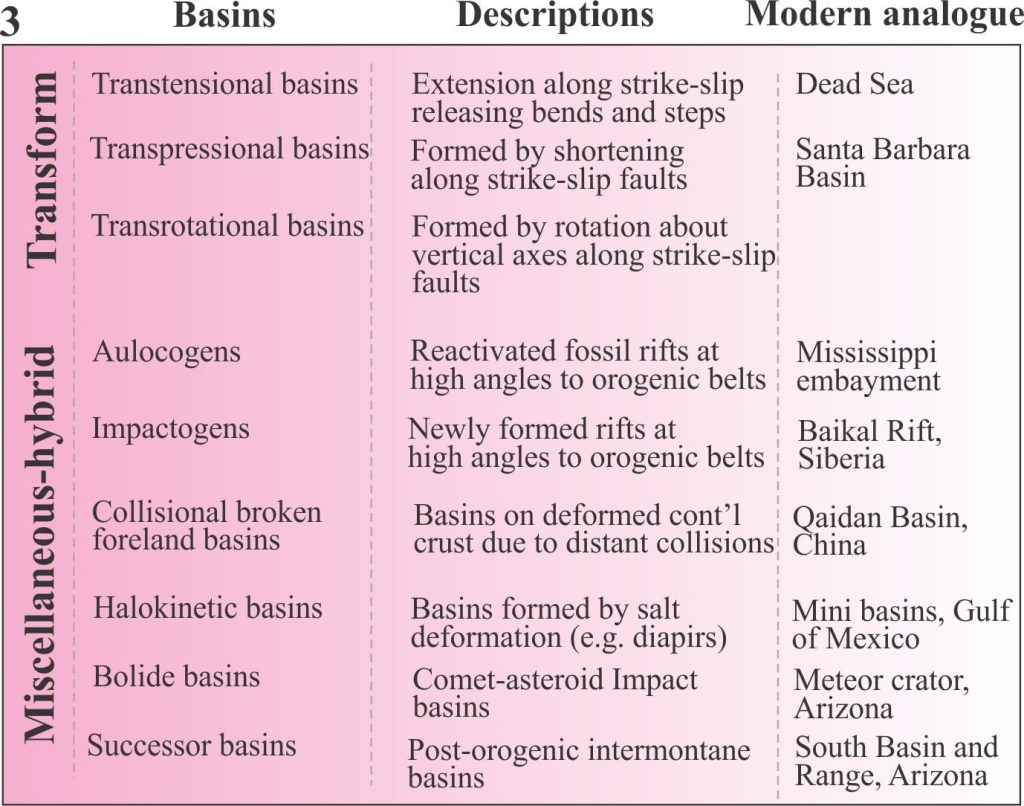

Panel 3. Ingersoll’s Table 1.2 (2012) of sedimentary basins has been modified slightly and split into three panels
From a purely geodynamic perspective, the Kingston et al. scheme is less useful because the 10 basin types refer to highly generalized plate tectonic settings, for example, Trench associated basins includes the actual deep trench, trench slope basins, forearc and interarc basins. There is also some ambiguity with their placement of foreland basins that overlie continental crust, but do not seem to fit any of the convergent margin designations for either continental or oceanic crust.
The successive Ingersoll schemes outline specific basin types, employing well-known terminology; the flow chart has been recreated from Ingersoll (2012, Table 1.2). It too is divided into the four main types of plate boundary, with 26 basins plus 6 ‘miscellaneous’ varieties. While 32 different basin types may seem unwieldy (Ingersoll offers a cryptic apology for this), each is much easier to apply because of the actualistic basis for the classification. In other words, the scheme is not encumbered by awkward details of stratigraphic architecture.
The Allen and Allen classification scheme
The third classification scheme considered here is from Allen and Allen (2013). It identifies basin types based on the primary mechanisms of subsidence and uplift, viz. isostasy, flexure, and the dynamic topography (dynamic topography is the subsidence or uplift of the surface caused directly by buoyancy-convection in the mantle. This is different to the topography generated during lithospheric adjustments towards isostatic equilibrium). Basins are further subdivided according to their location on continental and oceanic lithosphere.
Flexure here refers to loading by either or both tectonic and sediment loads. Foreland basins are classic examples where flexural subsidence is initiated by emplacement of thrust sheets but is augmented by the growing load of sediment. In contrast, subsidence in forearc basins, that sit atop a structurally telescoped wedge of cold oceanic crust, depends more on the tectonic load.
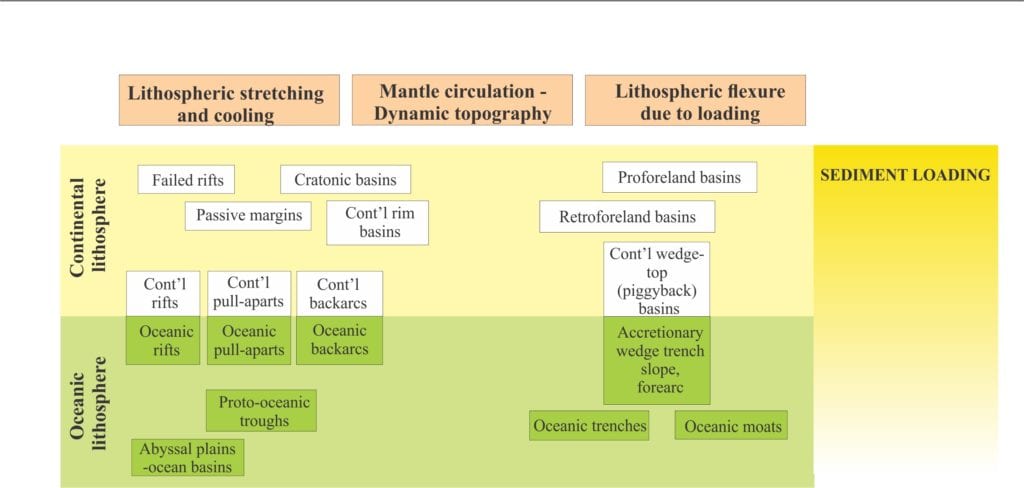

The basin classification according to Allen and Allen (2013), based on the principal subsidence mechanisms, including sediment load which is highest in continental basins, and of declining influence in oceanic basins.
Although not explicitly stated, the inclusion of sediment loading as an important determinant of subsidence implies there must be some knowledge of sediment thickness and the timing of sediment fill; in other words, stratigraphic architecture. Timing is important here because periods of rapid sediment flux will have a greater impact on the isostatic and flexural response than periods of little sediment input. Extended periods of erosion will have the opposite effect, promoting uplift.
Afterword
Classification schemes will evolve as our knowledge of sedimentary basins improves. The schemes shown here all have a reasonably finite number of basin types, some more useful than others depending on one’s approach to basin analysis. Theoretically, there is potential for a larger number of basin types if one wished to split categories into a myriad hybrids. But the utility of such splitting is questionable – at some point classification schemes become unwieldy. At present, the Ingersoll and Allen x 2 schemes seem to strike different but reasonable balances, depending on which basin analysis outcome you chose to explore.
Topics in this series
Sedimentary basins: Regions of prolonged subsidence
The rheology of the lithosphere
Isostasy: A lithospheric balancing act
The thermal structure of the lithosphere
Stretching the lithosphere: Rift basins
Nascent conjugate, passive margins
Basins formed by lithospheric flexure
Accretionary prisms and forearc basins
Basins formed by strike-slip tectonics
Allochthonous terranes – suspect and exotic
Source to sink: Sediment routing systems
Geohistory 1: Accounting for basin subsidence
Geohistory 2: Backstripping tectonic subsidence
